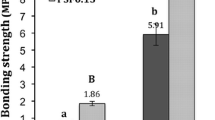Abstract
Fermentation residues (consisting of incompletely fermented fiber, adherent bacterial cells, and a glycocalyx material that enhanced bacterial adherence) were obtained by growing the anaerobic cellulolytic bacteria Ruminococcus albus 7 or Clostridium thermocellum ATCC 27405 on a fibrous fraction derived from lucerne (Medicago sativa L.). The dried residue was able to serve as an effective co-adhesive for phenol–formaldehyde (PF) bonding of aspen veneer sheets to one another. Testing of the resulting plywood panels revealed that the adhesive, formulated to contain 30% of its total dry weight as fermentation residue, displayed shear strength and wood failure values under both wet and dry conditions that were comparable with those of industry standards for PF that contained much smaller amounts of fillers or extenders. By contrast, PF adhesives prepared with 30% of dry weight as either unfermented lucerne fiber or conventional fillers or extenders rather than as fermentation residues, displayed poor performance, particularly under wet conditions.

Similar content being viewed by others
References
American Society for Testing and Materials (1999) Standard practice for estimating the percentage of wood failure in adhesive bonded joints. (ASTM D-5266-99) American Society for Testing and Materials, West Conshohocken, Pa.
Blumenkrantz N, Asboe-Hansen G (1973) New method for quantitative determination of uronic acids. Anal Biochem 54:484–489
Bradford MM (1976) A rapid and sensitive method for the quantitation of microgram quantities of protein utilizing the principle of protein-dye binding. Anal Biochem 72:248–254
Chase KB (2000) Design and evaluation of a continuous press with a multiple conical roll chamber. MS thesis, University of Wisconsin–Madison, Madison, Wis.
Dien BS, Nichols NN, Skory CD (2004) Converting herbaceous energy crops to ethanol: a review with emphasis on pretreatment processes. In: Hou CT (ed) Handbook of industrial biocatalysis. Dekker, New York (in press)
Dubois M, Giles KA, Hamilton JK, Rebers PA, Smith F (1956) Colorimetric method for determination of sugar and related substances. Anal Chem 28:350–356
Goering HK, Van Soest PJ (1970) Agriculture handbook 379. Agricultural Research Service (US Department of Agriculture), Washington, D.C.
Kamm B, Kamm M (2004) Principles of biorefineries. Appl Microbiol Biotechnol 64:137–145
Kudo H, Cheng KJ, Costerton JW (1987) Electron microscopic study of the methylcellulose-mediated detachment of cellulolytic rumen bacteria from cellulose fibers. Can J Microbiol 33:267–271
Lambuth AL (2013) Protein adheseives for wood. In: Pizzi A, Mittal KL (eds) Handbook of adhesive technology, 2nd edn. Dekker, New York, pp 457–478
Lynd LR, Wyman CE, Gerngross TU (1999) Biocommodity engineering. Biotechnol Prog 15:777–793
Lynd LR, Weimer PJ, Zyl WH van, Pretorius IS (2002) Microbial cellulose utilization: fundamentals and biotechnology. Microbiol Mol Biol Rev 66:506–577
Moore WE, Johnson DB (1967) Procedures for the chemical analysis of wood and wood products. Forest Products Laboratory (Forest Service, US Department of Agriculture), Madison, Wis., pp 67-027-1–67-027-7
National Institute for Standards and Technology (1995) Voluntary product standard PS 1-95 for construction and industrial plywood. National Institute for Standards and Technology, Washington, D.C.
SAS Institute (1998) SAS user’s guide: statistics ver. 7.0. SAS Institute, Cary, N.C.
Weimer PJ, Conner AH, Lorenz L (2003) Solid residues from Ruminococcus cellulose fermentations as components of wood adhesive formulations. Appl Microbiol Biotechnol 63:29–34
Weimer PJ, Lopez-Guisa JM, French AD (1990) Effect of cellulose fine structure on kinetics of its digestion by mixed ruminal microorganisms in vitro. Appl Environ Microbiol 56:2421–2429
Weimer PJ, Odt CL (1995) Cellulose degradation by ruminal microbes: physiological and hydrolytic diversity among ruminal cellulolytic bacteria. ACS Symp Ser 618:291–304
Acknowledgements
This research was supported by USDA Agricultural Research Service project 3655-41000-003D. We thank C.L. Odt and M. Becker for technical assistance. We also thank M. Boettcher for preparing the lucerne fiber.
Author information
Authors and Affiliations
Corresponding author
Rights and permissions
About this article
Cite this article
Weimer, P.J., Koegel, R.G., Lorenz, L.F. et al. Wood adhesives prepared from lucerne fiber fermentation residues of Ruminococcus albus and Clostridium thermocellum. Appl Microbiol Biotechnol 66, 635–640 (2005). https://doi.org/10.1007/s00253-004-1767-3
Received:
Revised:
Accepted:
Published:
Issue Date:
DOI: https://doi.org/10.1007/s00253-004-1767-3




